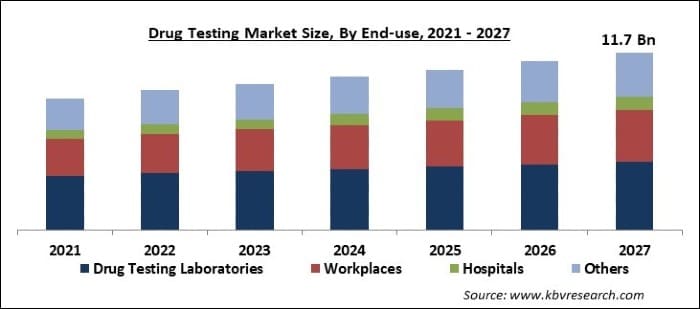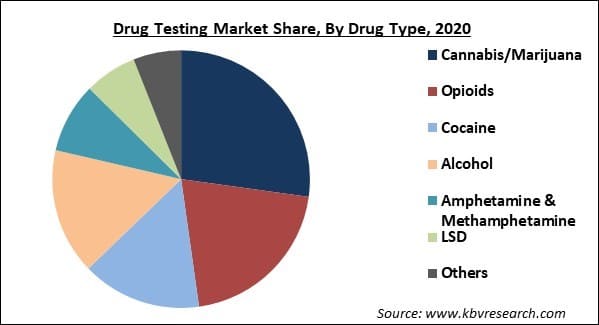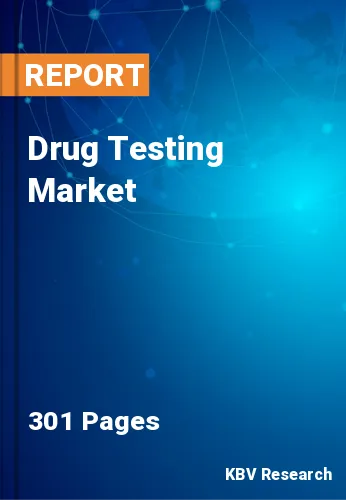The Global Drug Testing Market size is expected to reach $11.7 billion by 2027, rising at a market growth of 5.1% CAGR during the forecast period.
Drug testing refers to the process in which a biological sample is used to identify the presence or absence of a drug or its metabolites. This procedure can be done in many kinds of setting and using different techniques. Due to the fact that the body metabolizes different drugs at varied rates, the time period for identifying some drugs or metabolites can be highly specific and can differ extensively from substance to substance.
Along with some limitations, drug testing is very crucial in the clinical setting as the patient self-reporting, clinical examination, and collateral reporting are likely to misjudge the real incidence of substance use. Though, drug testing must be accompanied by psychosocial and history/physical assessment.
Various factors like legal cases, probation, divorce, custody, court-ordered testing, and employee testing make it necessary to take a drug test. In addition to it, various global, as well as country-level sporting events require drug screens to know whether athletes have utilized performance-enhancing drugs. There are various kinds of drug tests based on the objective of the test. These involve hair, urine, blood, saliva, and perspiration.

The most common testing is urine testing due to its properties like ease, cost-effective and rapid results. It is the sole testing method sanctioned for federally mandated testing. Urine testing is efficient enough to identify whether a substance has been utilized in the last some days for the majority of the drugs.
Several government initiatives with an aim to track and fight with substance abuse are boosting the market. The Substance Use and Addictions Program (SUAP) of Health Canada provide investments and contribute to projects that aim to reduce substance abuse issues in Canada. This initiative addresses substance use prevention, harm reduction, and treatment programs across Canada. In addition to it, in April 2016, the New York City government introduced a broad range of initiatives to train doctors and counselors doing the treatment of substance abuse and rising testing for synthetic opioids. The National Drug Control Budget claimed USD 34.6 billion in FY 2020 across five drug functional aspects in the U.S.: Operation, law enforcement, prevention, treatment, and interdiction.
COVID-19 has created a major slowdown of the businesses and economic activities around the world and would showcase a short-term adverse impact on the drug testing market because of the low or non-accessibility of medical facilities/treatment centers, harm reduction services vendors, and the fear of transmission of the infection. In order to decrease the burden on the healthcare system and reduce the possibility of virus transmission, several governments around the world offered guidelines to defer or suspend non-essential medical and surgical procedures.
There were strict lockdown guidelines and restrictions on travel, public gatherings, business operations, and shelter-in-place orders, and these aspects have further influenced the growth of the market. Various nations around the world are launching country-wide lockdowns and the temporary shutdowns of industries, manufacturing, business development, and production have been significantly affected. Trade barriers have further adversely impacted the demand-supply gap. Companies working in the drug testing market have faced disturbances in the global supply chain, decreased demand, or discontinuation of operations by their customers.
Based on Drug Type, the market is segmented into Cannabis/Marijuana, Opioids, Cocaine, Alcohol, Amphetamine & Methamphetamine, LSD and Others. The cannabis/marijuana segment garnered the highest revenue share of the drug-testing market in 2020. This massive revenue share of the segment is due to the fact that cannabis or marijuana is the extremely and commonly utilized illicit substance in major markets, thereby developing a massive demand for its testing kits and instruments.
Based on Sample Type, the market is segmented into Urine Samples, Oral Fluid Samples, Hair Samples and Other Samples. The urine samples segment emerged as the dominating segment of the drug-testing market by procuring the maximum revenue share in 2020. The segment would display a faster CAGR throughout the forecast period. As urine samples are the highly common sample type to identify the existence of illicit substances and this factor is responsible for the growth of the segment. Though, the growth of the market would be hindered by the fact that adulteration is getting more prevalent in urine samples to generate a false-negative test result.

Based on Product Type, the market is segmented into Consumables, Instruments, Rapid Testing Devices and Services. In 2020, the consumables segment obtained the maximum revenue share of the drug testing market. The growth of the market would be supported by the growing introduction of advanced consumables that offer advanced solutions to bring ease, accuracy, and rapid results in testing.
Based on End User, the market is segmented into Drug Testing Laboratories, Workplaces, Hospitals and Others. Workplaces would showcase the fastest growth rate throughout forecast years. This is credited to the increasing utilization of substance abuse screening in pre-employment and random drug tests to create drug-free premises. In addition to it, in case of workplace accidents, drug tests can be utilized to know whether an accident occurred under the influence of drugs, thereby eliminating the responsibility of the owner for damages. Organizations spend above USD 3,750 million on drug testing.
| Report Attribute | Details |
|---|---|
| Market size value in 2020 | USD 8 Billion |
| Market size forecast in 2027 | USD 11.7 Billion |
| Base Year | 2020 |
| Historical Period | 2017 to 2019 |
| Forecast Period | 2021 to 2027 |
| Revenue Growth Rate | CAGR of 5.1% from 2021 to 2027 |
| Number of Pages | 301 |
| Number of Tables | 510 |
| Report coverage | Market Trends, Revenue Estimation and Forecast, Segmentation Analysis, Regional and Country Breakdown, Companies Strategic Developments, Company Profiling |
| Segments covered | Drug Type, Sample Type, Product Type, End User, Region |
| Country scope | US, Canada, Mexico, Germany, UK, France, Russia, Spain, Italy, China, Japan, India, South Korea, Singapore, Malaysia, Brazil, Argentina, UAE, Saudi Arabia, South Africa, Nigeria |
| Growth Drivers |
|
| Restraints |
|
Based on Regions, the market is segmented into North America, Europe, Asia Pacific, and Latin America, Middle East & Africa. In the Asia Pacific, the market for drug testing would witness new growth avenues during the forecast period due to the increasing demand for substance abuse testing from developing nations like India and China. The demand for drug testing in these economies has been augmented by the increasing cases of substance abuse disorders, deadly road accidents, and drug-associated crimes. Though, the growth of the market would be slowed down by the absence of clear regulations associated with workplace drug testing.
Free Valuable Insights: Global Drug Testing Market size to reach USD 11.7 Billion by 2027
The market research report covers the analysis of key stake holders of the market. Key companies profiled in the report include Quest Diagnostics, Incorporated, Abbott Laboratories, F. Hoffmann-La Roche Ltd., Thermo Fisher Scientific, Inc., Siemens AG (Siemens Healthineers), Agilent Technologies, Inc., Bio-Rad Laboratories, Inc., Dragerwerk AG & Co. KGaA, Quidel Corporation, and Omega Laboratories, Inc.
By Drug Type
By Sample Type
By Product Type
By End User
By Geography
The global drug testing market size is expected to reach $11.7 billion by 2027.
The high consumption of drug and alcohol are driving the market in coming years, however, few nations have banned workplace drug testing have limited the growth of the market.
Quest Diagnostics, Incorporated, Abbott Laboratories, F. Hoffmann-La Roche Ltd., Thermo Fisher Scientific, Inc., Siemens AG (Siemens Healthineers), Agilent Technologies, Inc., Bio-Rad Laboratories, Inc., Dragerwerk AG & Co. KGaA, Quidel Corporation, and Omega Laboratories, Inc.
There were strict lockdown guidelines and restrictions on travel, public gatherings, business operations, and shelter-in-place orders, and these aspects have further influenced the growth of the market.
The North America emerged as the leading region of the global drug-testing market by obtaining the highest revenue share.
Our team of dedicated experts can provide you with attractive expansion opportunities for your business.

